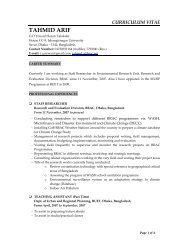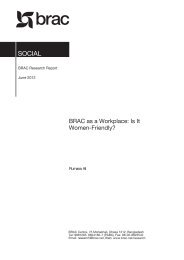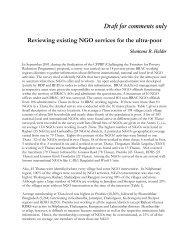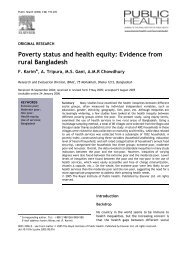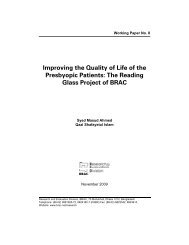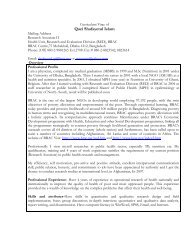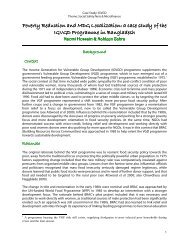Combining health and social protection measures to reach the ultra ...
Combining health and social protection measures to reach the ultra ...
Combining health and social protection measures to reach the ultra ...
You also want an ePaper? Increase the reach of your titles
YUMPU automatically turns print PDFs into web optimized ePapers that Google loves.
Access <strong>to</strong> <strong>health</strong><br />
Discrimination as a barrier <strong>to</strong><br />
accessing mental <strong>health</strong> care<br />
Article by Graham Thornicroft<br />
Although each year up <strong>to</strong> 30% of <strong>the</strong> population<br />
worldwide has some form of mental illness, at least<br />
two thirds receive no treatment. This under-treatment<br />
occurs even in countries with <strong>the</strong> best resources 1 . In <strong>the</strong> USA,<br />
for example, 31% of <strong>the</strong> population are affected by mental<br />
illness every year, but 67% of <strong>the</strong>se individuals are not<br />
treated 2 . Moreover, in Europe mental illness affects 27% of<br />
people every year, 74% of whom receive no treatment 3 . The<br />
proportions of people with mental illness who are treated in<br />
low- <strong>and</strong> medium-resource countries (LAMIC) are far less, for<br />
example a recent worldwide survey found that <strong>the</strong> proportion<br />
of respondents receiving mental <strong>health</strong> care over 12 months<br />
was as low as 1.6% in Nigeria, <strong>and</strong> that in most of <strong>the</strong> 17<br />
countries studied only a minority of people with severe<br />
disorder received treatment 4 .<br />
A WHO review of 37 studies across <strong>the</strong> world, for example,<br />
found that <strong>the</strong> proportion of people untreated for particular<br />
conditions is: schizophrenia 32.2%; depression 56.3%;<br />
dysthymia 56.0%; bipolar disorder 50.2%; panic disorder<br />
55.9%; generalized anxiety disorder 57.5%; <strong>and</strong> obsessive<br />
compulsive disorder 57.3%; alcohol abuse <strong>and</strong> dependence<br />
78.1% 5-7 . Indeed in one particular study of depressed people<br />
in St Petersburg only 3% were treated 8 , both because of <strong>the</strong><br />
low level of coverage of services, <strong>and</strong> because of dem<strong>and</strong><br />
limiting fac<strong>to</strong>rs such as <strong>the</strong> need for out-of-pocket payments<br />
<strong>to</strong> afford treatment.<br />
Two contribu<strong>to</strong>ry fac<strong>to</strong>rs <strong>to</strong>wards this degree of neglect are<br />
(i) <strong>the</strong> reluctance of many people <strong>to</strong> seek help for mental<br />
illness related problems because of <strong>the</strong>ir anticipation of<br />
stigma should <strong>the</strong>y be diagnosed, <strong>and</strong> (ii) <strong>the</strong> reluctance of<br />
many people who do have a diagnosis of mental illness <strong>to</strong><br />
advocate for better mental <strong>health</strong> care for fear of shame <strong>and</strong><br />
rejection if <strong>the</strong>y disclose <strong>the</strong>ir condition 1 .<br />
Stigma: a combination of ignorance,<br />
prejudice <strong>and</strong> discrimination<br />
Stigma is a term which has evaded clear, operational<br />
definition 9-12 . It can be considered as an amalgamation of<br />
three related problems: a lack of knowledge (ignorance <strong>and</strong><br />
misinformation), negative attitudes (prejudice), <strong>and</strong> excluding<br />
or avoiding behaviours (discrimination) 13-17 . The combination<br />
of <strong>the</strong>se three elements has a powerful force for <strong>social</strong><br />
exclusion 13 . Indeed <strong>the</strong>re is no known country, society or<br />
culture in which people with mental illness with a diagnosis<br />
are considered <strong>to</strong> have <strong>the</strong> same value <strong>and</strong> <strong>to</strong> be as<br />
acceptable as people who do not have mental illness.<br />
Second, <strong>the</strong> quality of information that we have is relatively<br />
poor, with very few comparative studies between countries or<br />
over time. Third, <strong>the</strong>re do seem <strong>to</strong> be clear links between<br />
popular underst<strong>and</strong>ings of <strong>the</strong> meaning of a diagnosis of<br />
mental illness, if people in mental distress want <strong>to</strong> seek help,<br />
<strong>and</strong> whe<strong>the</strong>r <strong>the</strong>y feel able <strong>to</strong> disclose <strong>the</strong>ir problems 18 . The<br />
core experiences of shame (<strong>to</strong> oneself <strong>and</strong> one’s family) <strong>and</strong><br />
blame (from o<strong>the</strong>rs) are common everywhere stigma has<br />
been studied, but <strong>to</strong> differing extents. Where comparisons<br />
with o<strong>the</strong>r conditions have been made, <strong>the</strong>n people with a<br />
diagnosis of mental illnesses are more, or far more,<br />
stigmatized 19,20 , <strong>and</strong> have been referred <strong>to</strong> as <strong>the</strong> “ultimate<br />
stigma” 21 . Finally, rejection <strong>and</strong> avoidance of people with a<br />
diagnosis of mental illness appear <strong>to</strong> be universal<br />
phenomenon, <strong>and</strong> a recent study of terms used by school<br />
children <strong>to</strong> refer <strong>to</strong> mental illness revealed 250 different<br />
words <strong>and</strong> phrases, none of which are positive 22 .<br />
Limited access <strong>to</strong> mental <strong>health</strong> care<br />
It is only recently that <strong>the</strong> full potency of such barriers <strong>to</strong><br />
finding treatment <strong>and</strong> care have been recognized 23 . For<br />
example, studies from several countries have consistently<br />
found that even after a family member has developed clearcut<br />
signs of a psychotic disorder, on average it is over a year<br />
until <strong>the</strong> unwell person first receives assessment <strong>and</strong><br />
treatment 24-26 . A survey of almost 10 000 adults in <strong>the</strong> USA<br />
has added more detail <strong>to</strong> this picture. The results showed that<br />
<strong>the</strong> majority of people with mental disorders eventually<br />
contact treatment services, but <strong>the</strong>y often wait a long time<br />
before doing so: with average delays before seeking help of<br />
eight years for mood disorders, <strong>and</strong> at least nine years for<br />
anxiety disorders. People who wait longer than average before<br />
receiving care are more likely <strong>to</strong> be young, old, male, poorly<br />
educated, or a member of a racial/ethnic minority 27 .<br />
Where do people go <strong>to</strong> try <strong>to</strong> find help? The detailed US<br />
survey just mentioned also asked this question <strong>and</strong> produced<br />
some surprising answers. Only about one third (41%) of<br />
people who had experienced mental illness in <strong>the</strong> previous<br />
year had received any treatment: 12% from a psychiatrist,<br />
16% from a non-psychiatric mental <strong>health</strong> specialist, 23%<br />
treated by a general medical practitioner, 8% from a <strong>social</strong><br />
services professional <strong>and</strong> 7% from a complementary or<br />
alternative medical provider. In terms of treatment adequacy,<br />
mental <strong>health</strong> specialists provided care that was at least<br />
062 ✜ Global Forum Update on Research for Health Volume 4




